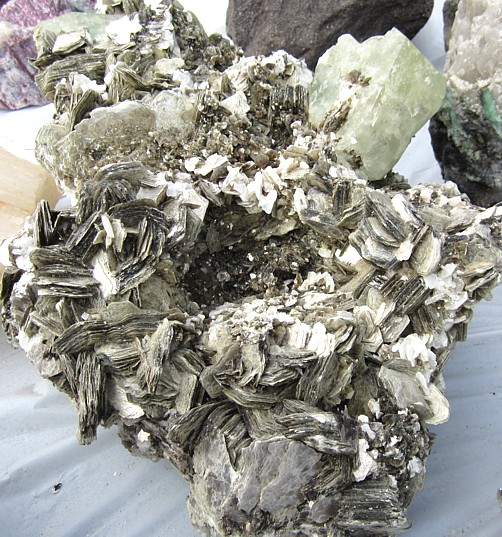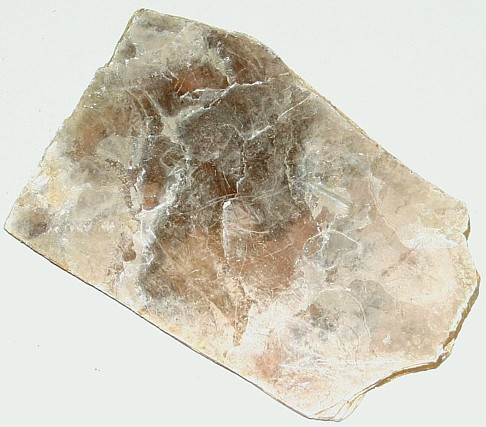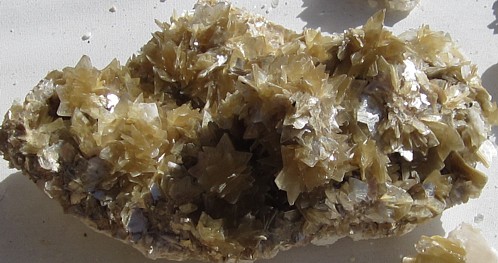|
.
Muscovite Mineral Facts:
Chemical Formula: KAl2(AlSi3O10)(F,OH)2
While predominantly a potash
mica, nearly all muscovite contains some soda, due to the isomorphous
mixture of the paragonite molecule. It also frequently contains small
amounts of ferrous and ferric iron, magnesium, calcium, sodium, lithium,
fluorine, titanium, etc.
Colors:
Colorless
or of some light shade of green, gray, yellow or red.
Hardness:
2
Density: 2.76
to 3.1
Cleavage:
Perfect basal cleavage
that is very easily developed as it is in all the Mica minerals.
The cleavage folia are flexible
and
elastic.
Crystallography: Monoclinic
The
axial angle is nearly 90. It occurs
in tabular crystals with a prominent base. The presence of prism faces
having angles of 60 and 120 with each other gives the plates a
diamond-shaped outline, making them simulate orthorhombic symmetry. If
the clinopinacoid faces are also present, the crystals become
hexagonal in outline with apparently hexagonal symmetry. The prism faces
are roughened by horizontal striations and frequently taper.
Luster:.
Vitreous to pearly
luster. It is translucent to transparent.
Optics:
(Refractive Index):
=
a= 1.562, b = 1.606; y = 1.606
|

Muscovite Mica |
|
Composition,
Structure and Associated Minerals:
Occurrence. A widespread and very common rock-making mineral.
Found in such igneous rocks as granite and syenite. Especially
characteristic of pegmatite veins, and found lining cavities in granites,
where it has evidently been formed by the action of mineralizing vapors
during the last stages of the formation of the rock. Muscovite is chiefly
characteristic of the deep-seated igneous rocks, and is not found in the
recent eruptive rocks. It is also very common in metamorphic rocks, as
gneiss and schist, forming the chief constituent in certain mica-schists. In
some schistose rocks it occurs in the form of fibrous aggregates of minute
scales having a silky luster, but which do not show so plainly the
characters of the mineral. This variety is known as sericite, and is usually
the product of alteration of feldspar. Muscovite also originates, as the
alteration product of several other minerals, as
topaz,
kyanite,
spodumene,
adalusite,
scapolite, etc.
Muscovite occurs in large, ill-defined crystals in pegmatites, and in
smaller flakes in granites and other acid igneous rocks, in some sandstones
and slates and in various schists and other metamorphic rocks. It is found
also in veins. It is in some cases an original pyrogenic mineral, in other
cases a metamorphic mineral and in still other cases a secondary mineral
resulting from the alteration of alkaline aluminous silicates. In the
pegmatite veins, muscovite occurs associated with quartz and feldspar, with
tourmaline,
beryl,
garnet,
apatite,
fluorite, etc. It is found often in
these veins in large blocks, which are at times several feet across.
Muscovite is very stable under surface conditions. Its principal weathering
change is into a partially hydrated substance, which may be called
hydromuscovite. It alters also into scaly chlorite mineral products, into
steatite, and serpentine. Sericite is a yellowish or greenish muscovite that
occurs in thin, curved plates in some schists and metal ore veins. Fuchsite
is a chromiferous variety of an emerald-green color. The name muscovite was
so called from the popular name of the mineral, Muscovy-glass, because of
its use as a substitute for glass in Russia. Mica was probably derived from
the Latin micare, meaning to shine.
Identification and Diagnostics
Before the blowpipe thin flakes of muscovite fuse on their edges to a
gray mass. In the closed tube the mineral yields water which, in some cases,
reacts for fluorine. It is insoluble in acids under ordinary conditions, but
is decomposed on fusion with alkaline carbonates. Unattacked by boiling
hydrochloric or sulphuric acids. Characterized by its micaceous structure,
cleavage and light color. Told from phlogopite by its not being decomposed
in sulphuric acid and from lepidolite by not giving a crimson flame
(positive test for lithium).
|

Sheet form muscovite Mica |
|
|
Occurrence,
Localities and Origins:
Muscovite is found in the United States in
commercial deposits chiefly in the Appalachian and Rocky Mountain regions.
The mineral occurs in all regions where pegmatites and acid igneous rocks
exist. It is mined in North Carolina, South Dakota, New Hampshire, Virginia
and other states. While phlogopite (amber mica) is produced in some
countries all the mica produced in this country is of the muscovite variety.
The most productive muscovite pegmatite veins occur in North Carolina,
mostly in Mitchell, Yancey, Haywood, Jackson and Macon counties, and in the
Black Hills of South Dakota. Of less importance are the deposits in
Colorado, Alabama and Virginia. Muscovite has been mined in New Hampshire,
Maine and Connecticut. Large deposits are found in Canada in the township of
Grenville, east of Ottawa, and in a district to the east of Quebec. Large
and important deposits occur in India.
Uses:
Muscovite is used in two forms, (i) as sheet mica, and
(2) as ground mica. The sheet mica comprises thin cleavage plates cut into
shapes. It is used in making gas-lamp chimneys, lamp shades, and windows in
stoves because it is more resistant to shattering than glass when exposed to
extreme heat changes. The greater portion is used as insulators in
electrical appliances, though for some forms of electrical apparatus the
amber mica is better. Because of the comparatively high cost of large mica
plates, small plates are sometimes built up into larger ones. The ground
mica consists of small crystals and the waste from the manufacture of sheet
mica ground very fine. It is used in the manufacture of wall paper, heavy
lubricants and fancy paints. It is also mixed with shellac and melted into
desired forms for electrical insulators. Ground mica is used in the
well-drilling industry as an element in drilling fluids. The flat mica
flakes help prevent the loss of circulation flow by sealing off porous
sections of the drill hole. Mica use in well drilling mud accounted for 15%
of the total mica use in 2008. Mica is also used as an extender and filler
in the plastics industry. The transparent material (also known as isinglass)
for stove doors, lanterns, etc. Scrap mica, or the waste material in the
manufacture of sheet mica, is used in many ways, as in the manufacture of
wall papers and wall texture materials to give them a shiny luster; as a
lubricant when mixed with oils; as a nonconductor of heat and as a
fireproofing material. Total world production is about 350,000 tons per
year.
Return to the
Mineral Collectors Information Page |



